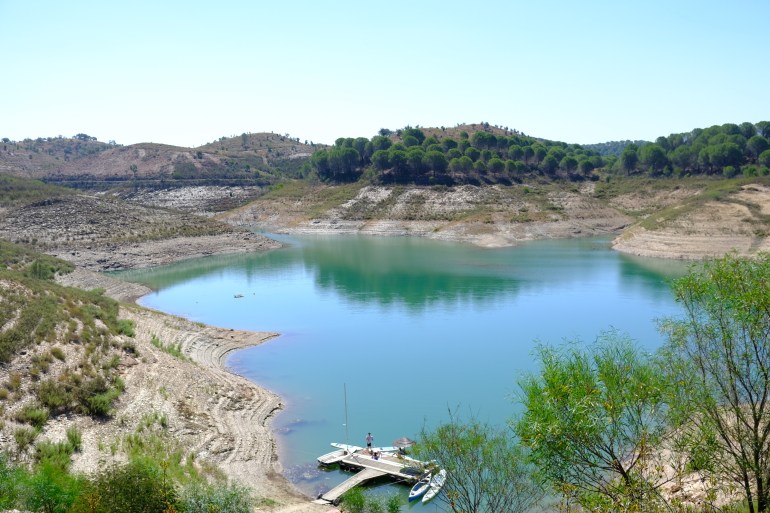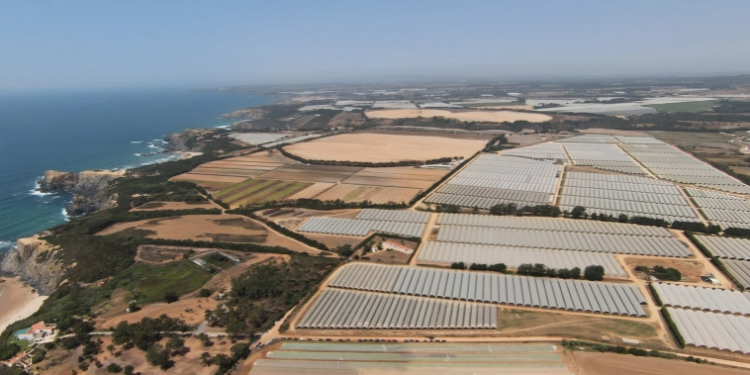Environmental organisations and residents protest the exploitation of Odemira’s land and water resources for greenhouses.
Odemira, Portugal – Sitting in her home in a white-washed village nestled in Alentejo’s gently rolling hills, 92-year-old Inácia Cruz likes to reminisce about simpler times.
“This region was rich in bread,” she says wistfully. “We would produce olive oil, cereals and cork. We didn’t need to buy things from abroad. We grew our own food and neighbours helped each other.”
Over the decades, she saw a radical transformation of the landscape of Odemira, a rural municipality in the southwestern Alentejo region.
In the 1960s, a dam was built under the Estado Novo dictatorship, with promises that irrigation would develop agriculture and improve production in the dry area. The reservoir was named after Inácia’s village, Santa Clara.
While some farmers replaced the traditional patchwork of cereal fields, grassland and fallow land with irrigated crops, it was only in the late 1980s that industrial farming picked up, with the establishment of hundreds of hectares of strawberry greenhouses by millionaire French businessman Thierry Roussel.
‘The Frenchman’s greenhouses’
”Some of my neighbours worked there, in the Frenchman’s greenhouses, but the business failed and they were never paid the salaries they were owed,” says Inácia.
Even with subsidies from the European Union and funding from the Portuguese state and a state-owned bank, the 550-hectare (1,359-acre) greenhouses went bankrupt in just a few years, ending with an estimated $30m loss.
Roussel fled Portugal, leaving his debts behind, the land littered with plastic and the soil eroded by the heavy use of agrochemicals.
But in the last 18 years, foreign companies have started investing in Odemira again, turning the region into a hub for intensive monoculture farming.
The region’s mild climate, which allows longer growing seasons, started attracting multinational berry producers again in 2004, when American company Driscoll’s, the world’s largest berry company with a monopoly of patented plants, established greenhouses there to feed Europe’s growing appetite for fresh berries.
The availability of land, water from the Santa Clara reservoir and millions of euros in EU agricultural subsidies fuelled an export boom that saw Portugal’s sale of berries grow exponentially over the past 10 years, bringing in an estimated 250 million euros ($242m) in 2020.
More than 90 percent of the berries produced are exported north to places like Belgium, France, Germany, the Netherlands, Scandinavia, and the United Kingdom.
Inácia is acutely aware of the demise of the region’s traditional ways of growing food, based on an ancient silvopastoral model that combines oak and fruit trees with rain-fed crops and livestock.
”Now it’s shameful, we can’t even feed ourselves. We have to import wheat to make our own bread,” Inácia murmurs disapprovingly, shunning the model that privileges international markets over sustainable local production.
She says it has also meant a transformation of social relations.
“There was more kindness before. Less greed, less malice.”
Biodiversity hotspot
While Inácia’s village is right next to a reservoir that supplies berry producers, most of the greenhouses have been established by the coast, inside Southwest Alentejo and Vicentine Coast Natural Park, a hotspot for biodiversity.
”[Southwest Alentejo] is one of Europe’s most precious nature preserves and last wild coastal areas,” says Paula Canha, a biologist who has dedicated most of her career to studying the region’s unique biodiversity and endemic species.
In 1988, Southwest Alentejo was classified as protected landscape. In 1995, it was turned into a nature park and included in Europe’s Natura 2000 network of protected areas for rare and threatened habitats.
However, the agricultural companies operating in the area deny their business has a significant impact on the environment, saying the irrigation network established by the dam predates the park and should have priority over nature conservation.
”Agriculture is important, but it needs to have limits. We need to find a balance between food production and conservation,” says Canha.
Greenhouses cover more than 1,700 hectares (4,200 acres) of the nature park. In 2019, the government approved a resolution to allow the area in which greenhouses can be established to reach 40 percent of a designated agricultural zone inside the park, allowing greenhouse covered areas to nearly triple to 4,800 hectares (11,861 acres).
According to Canha, one of the main problems is the lack of clear regulations and law enforcement.
“Inspections are almost non-existent, there’s a lot of neglect from local authorities. For years we had companies breaking the law with impunity,” she says.
Portugal’s Ministry of Environment and the park authorities did not respond to Al Jazeera’s multiple requests for comment on the impact of intensive agriculture in the protected area. Odemira’s mayor refused to be interviewed.
Making way for greenhouses
According to biologists and conservationists, intensive monoculture farming depends on the use of agrochemicals, and to establish greenhouses companies are levelling the ground, draining the soil and covering it with plastic.
Water with fertilisers runs off into watercourses and seeps into the soil, contaminating the region’s scarce water resources. The damage can be irreversible.
In addition to that, Canha says, “many of these greenhouses are being established right next to cliffs, causing faster erosion”.
“They are destroying the soil structure to a point that restoring it will be almost impossible. Everything underneath the plastic dies.”
Canha was part of a team of biologists and conservationists who mapped out the region’s unique Mediterranean temporary ponds, priority habitats protected under national and European legislation.
Over the past 20 years, many of the ponds have been destroyed to make way for greenhouses.
”Despite all our efforts to preserve these unique ponds, they continued to be destroyed,” says Rita Alcazar, from LPN, an environmental organisation that recently filed a criminal complaint against a British-owned company accused of destroying five ponds to grow strawberries to export to the UK and Scandinavia.
In a statement sent by email about the ponds, AHSA, Odemira’s association of fruit growers, told Al Jazeera “a few mistakes were made in the past”, but that today, “companies are subjected to very tight control by clients”, and uphold “the highest standards”.
Rising against agribusiness
It is not just environmental organisations protesting against the destruction of priority habitats, the erosion of the soil and the contamination of water resources.
Outraged by the government’s decision to increase the area in which greenhouses are allowed, several residents have started organising against the agro-industry in Odemira.
”This area should be protected, but it’s being abandoned to favour economic interests,” says Laura Cunha, who joined forces with other residents to form the group Juntos pelo Sudoeste (“Together for the Southwest”) in 2019.
Since then, they have organised protests, written petitions and vowed to take the government to court to protect the region’s native flora and fauna.
Agricultural companies argue they are bringing investment to an impoverished region, and many consider the industry’s growth a success.
But for Juntos pelo Sudoeste, the economic model of intensive greenhouses depends on the exploitation of migrant labour and the natural environment.
The greenhouses rely mostly on imported materials – from patented plants, metal structures and plastic covers to agrochemicals – as well as thousands of overworked and underpaid migrant workers who come mostly from South Asia to pick berries too delicate for mechanised harvesting.
“It doesn’t benefit local communities, it’s depleting water and soil to enrich only a few,” Cunha tells Al Jazeera.
”The main problem is that the state condones this, and continues to favour agribusiness,” says Cunha.
In 2017, Portugal’s Prime Minister António Costa visited greenhouses in Odemira producing raspberries for Driscoll’s, praising foreign investment in the region.
”These multinational companies have an extractivist mindset, they are here to profit the most out of local resources and then leave,” says Diogo Coutinho, who founded the organisation SOS Rio Mira to advocate for the protection and sustainable management of local water resources.
Water is a key issue as Portugal and Spain suffer the driest climate for at least 1,200 years, with heatwaves and prolonged droughts becoming increasingly common.
Reports have warned the region is in danger of becoming a desert before the end of the century. But demands for water in the region continue to increase.
”There is less water because it rains less. With deforestation the soils are impoverished and there is less water retention. But the consumption of water is increasing because intensive farming continues to grow,” says Coutinho, who lives right next to the Santa Clara dam and has seen some of his neighbours run out of water.

Water levels in the dam dropped from 96 percent in July 2010 to an alarming 36 percent this year.
According to Coutinho and other residents and activists, the problem is the unfair distribution of increasingly scarce water resources, since the association that controls the supply from the dam is managed by agricultural companies that consume about 90 percent of the water.
António Rosa, a farmer who grows peanuts and sweet potatoes on a small plot of land, was one of more than 100 local residents who received a letter from the water management association warning them they would no longer get water from the reservoir and would have to find an alternative irrigation source.
”We’re being denied access to the water so it can continue supplying multinational companies here,” says Rosa.
“The dam was built with public funds but it’s managed privately. It was built to supply farmers only in the driest months, but these companies need irrigation all year. Their intensive model is not sustainable, it’s completely disconnected from the territory and local conditions,” he says.
For him, the solution is to go back to the region’s roots.
“We used to grow crops adapted to dry lands. We had food sovereignty and local knowledge on how to deal with drought and live sustainably,” he says. “We just need to value it again.”
This project was developed with the support of Journalismfund.eu.










